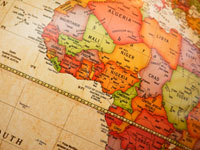The World in 2100: Ten Billion People, No Oil and Not Enough Food
With global population now at seven billion, it may be time to start planning for what the world will look like in the coming years.
Though most of us won't be around to see it, the United Nations has projected that our incredible population growth will level off at around 10 billion people by the year 2100.
Already, at seven billion, we are experiencing severe poverty, hunger, a shortage of resources, increased urbanization and climate change issues.
Will we be doomed by 2100, or can we make it work? Since we've only got one planet (so far), let's hope for the latter.
By 2100, 80 percent of the world's populations will live in cities.
Increased urbanization will be one of the main ways the planet will sustain 10 billion people. There will be a lot of new cities, and mega-cities (cities with a population of over 20 million) will become more common.
 Thinkstock |
Possible candidates for mega-city status include: Beijing, Delhi, Jakarta, Mexico City, Mumbai, São Paulo, and Shanghai.
The world will have a few hundred languages at the most.
Right now, there are over 7,000 languages spoken. But lesser used languages will fall by the wayside, while English will become the most used form of communication around the world.
22.3 percent of people will be at least 65 years old.
That will be a huge increase, up from 7.6 percent in 2010.
The burden on the youth to carry the old will be greater than ever.
Most of the population growth will come from the developing world, especially Africa.
 Thinkstock |
Africa's population will go from one billion in 2010 to3.6 billion in 2100.
The demographic shift, and subsequent geopolitical shift, will be momentous, when there are "five sub-Saharan Africans for every European."
Other regions will see slower growth. For example, the U.S. population will rise from today's 311 million to 478 million.
Global life expectancy will be around 81 years.
Nowadays, our life expectancy is at 68 years.
The UN report does not, however, include the possibilities of improvements in life expectancy from "research in genetic engineering, nanomedicine, exponentially increasing intelligence."
It also doesn't consider risks such as alien invasion or pandemics in its projections.
An increasing population will see a food shortage — thanks to global warming.
We already have 925 million hungry people worldwide. An increase in population will add to that number, and global warming may hinder our ability to fight the problem.
Rising temperatures worldwide "shorten the growing season in the tropics and subtropics, increase the risk of drought, and reduce the harvests of dietary staples such as rice and maize by 20 percent to 40 percent." That means hundreds of millions of people will have to look elsewhere when traditional sources of food dry up.
The world's coral reefs, and the delicate ecosystems they house, could disintegrate.
 Thinkstock |
Carbon dioxide is expected to reach a level of 560 parts per million by the end of the century, resulting in the destruction of over 9,000 coral reefs worldwide.
Besides being nice to look at, reefs are home to thousands of species of fish and are the feeding and spawning grounds of countless other animals.
The ability of coral reefs to regenerate is compromised when water acidity levels and temperature are too high.
Use of oil, natural gas and coal will drop to almost zero.
These finite sources of energy will eventually become extinct, especially at our rate of consumption. Some tables have oil use declining at five percent a year after 2040. Gas is expected to decline even faster.
Hydro energy and renewable energy (such as wind and solar power) are expected to see continued increasing use, and should become our primary sources of power by 2100 and beyond.
A more mobile talent market will mean less homogeneity in countries like China and Japan.
An increasingly globalized world will mean more and more people taking their talents abroad, crossing borders to find better opportunities. Diversity will become more common in countries that now have general ethnic homogeneity, as Americans travel to Asia and an even bigger melting pot in Europe.
Countries and cities that don't go after global talent will fall behind.
There might be up to five billion more of us — or a billion fewer.
The UN report that predicts 10 billion people by 2100 also had two alternate, though less likely, scenarios: there could be as many as 15.8 billion people, or as few as 6.2 billion.
While 6.2 billion would be manageable, 15.8 could be "a danger" to the planet.
We would need to take drastic steps to control population levels if we were to survive. 10 billion may be too much of a strain as it is.